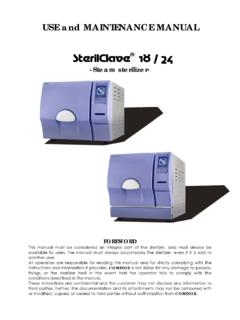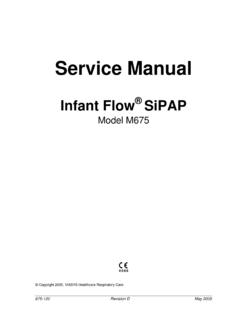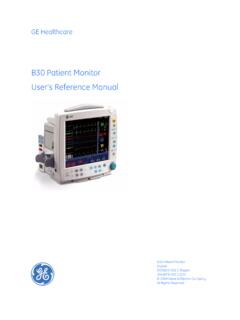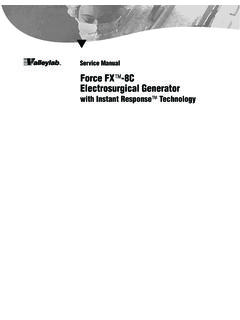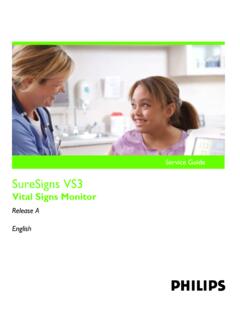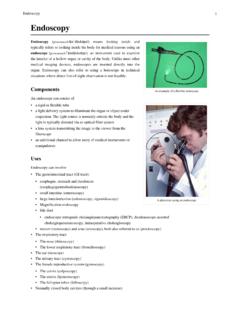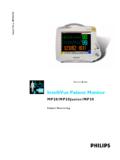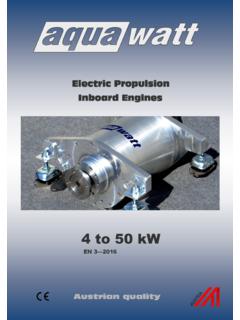Transcription of PiCCO2 - Frank's Hospital Workshop
1 PiCCO2 (PC8500) Version Operator s Manual and Product Information pulsion Medical Systems SE Hans-Riedl-Str. 17 D-85622 Feldkirchen Phone: +49 - (0)89 - 45 99 14 0 Fax +49 - (0)89 - 45 99 14 18 E-mail: Internet: pulsion EN 03/2013 March 2013 Art. No.: PC856EN_R11 About this Manual Page II Operator s Manual PiCCO2 Version About this Manual WARNING: Important items of information, activities where operating personnel must proceed with extreme caution in order to avoid injury to themselves or the patient. These items of information are always shown in BOLD. CAUTION: Items of information for which careful attention must be paid in order to avoid damage to the equipment or inaccurate data as well as operational errors. These items of information are always shown in BOLD. WARNING: Read the operating instructions carefully before using the PiCCO2 equipment!
2 Table of Contents Operator s Manual PiCCO2 Page Version III Table of Contents About this Manual .. II Table of Contents .. III List of Figures .. VII A General Information .. A-1 1 Intended Use .. A-1 2 Indications .. A-1 3 Contraindications .. A-2 4 Warnings .. A-3 5 Safety instructions .. A-5 B Principles of Measurement and Parameters .. B-1 1 Introduction .. B-1 2 Transpulmonary Thermodilution Technique .. B-2 Principle .. B-2 Transpulmonary Cardiac Output .. B-2 Transpulmonary volume determination .. B-3 GEDV / ITBV .. B-3 EVLW .. B-4 Additional Thermodilution Parameters .. B-4 3 Continuous Pulse Contour Analysis .. B-5 Principle .. B-5 Calibration of the Pulse Contour Cardiac Output .. B-5 Continuous haemodynamic determination .. B-6 MAP / CVP / HR .. B-6 PCCO .. B-6 SVV / PPV .. B-7 SVR.
3 B-7 CPO .. B-7 dPmx .. B-7 4 Central venous oximetry .. B-8 Principle .. B-8 Determination of ScvO2 .. B-8 Oxygen delivery and oxygen consumption: DO2 and VO2 .. B-8 Table of Contents Page IV Operator s Manual PiCCO2 Version DO2 ..B-8 VO2 ..B-8 5 Pulse oximetry and pulse dye densitometry .. B-9 Principle of pulse Principle of pulse dye densitometry ..B-9 Principle of ICG elimination detection ..B-10 Parameters of pulse oximetry and pulse dye densitometry ..B-10 6 Parameter groups and ranges of normal values .. B-11 C Installation and setup .. C-1 1 Unpacking and inspection .. C-1 2 Functionality and user interaction .. C-3 Screen elements .. C-3 User interaction .. C-3 Touchscreen .. C-4 Function keys .. C-4 Navigation dial and navigation keys .. C-5 3 Setup and measurement: Step by step .. C-6 Connectors and connections.
4 C-6 Patient cables .. C-6 Monitor connections .. C-7 Patient and monitor wiring .. C-8 Thermodilution and Pulse Contour Analysis .. C-9 Central venous oxygen saturation .. C-10 Application of injectate temperature sensor housing and CeVOX probe at the same time .. C-10 Transmission of continuous pressure to bedside monitor .. C-10 Setup and start .. C-11 Mains voltage .. C-11 Switch on the C-11 Enter patient data .. C-12 Zero adjustment .. C-15 Zero adjustment of arterial pressure (AP) and central venous pressure (CVP) .. C-15 Central venous oxygen saturation .. C-16 ScvO2 calibration .. C-16 SaO2 Input .. C-18 Indocyanine Green (ICG) measurement .. C-19 Table of Contents Operator s Manual PiCCO2 Page Version V Non-invasive ICG measurement .. C-19 Display of results .. C-21 Calculation of ICG quantity.
5 C-22 Thermodilution and calibration of pulse contour analysis .. C-23 4 Display Options .. C-27 Information bar .. C-27 Real time pressure curve .. C-28 Parameter fields .. C-29 C-30 SpiderVision .. C-31 Trend .. C-32 5 Monitor and Display Configuration .. C-33 Patient settings .. C-33 Information input .. C-33 Predicted body weight .. C-34 Monitor settings .. C-34 Configuration of parameter display .. C-35 Setting of alarm limits .. C-36 PCCI change warning .. C-36 Parameter settings .. C-37 Spider configuration .. C-38 Trend configuration .. C-39 Measurement configuration .. C-40 Configuration of thermodilution measurement .. C-40 Configuration of central venous catheter .. C-41 Configuration of ScvO2 measurement .. C-41 Configuration of ICG measurement .. C-41 Normal and Target Values.
6 C-42 6 Alarms, messages and troubleshooting .. C-43 Alarms .. C-44 Error Messages .. C-44 Additional information .. C-47 7 Help Functions .. C-49 8 Printout .. C-50 USB Virtual Printing Option .. C-50 Table of Contents Page VI Operator s Manual PiCCO2 Version Label Printer .. C-50 9 Battery Function .. C-51 10 Cleaning and C-52 General remarks .. C-52 Precautions .. C-52 Cleaning .. C-53 Disinfection .. C-53 D Disposables / Accessories .. D-1 1 D-1 PiCCO Catheter (arterial thermodilution catheter) .. D-1 PiCCO Monitoring D-2 Injectate Temperature Sensor Housing .. D-2 CeVOX probe .. D-3 2 Accessories .. D-4 E Appendix .. E-1 1 Technical Data .. E-1 2 Maintenance and Service .. E-4 Classification ..E-4 Maintenance ..E-4 Disposal of electrical and electronic equipment ..E-5 3 Interfaces .. E-6 4 EMC-Requirements.
7 E-7 5 Equations for Calculated Values .. E-11 General ..E-11 Output ..E-12 Preload Volume ..E-13 Afterload ..E-14 Contractility ..E-15 Organ Function ..E-15 Oxygenation ..E-16 6 Flow E-18 7 Symbols .. E-19 8 Warranty .. E-20 List of Figures Operator s Manual PiCCO2 Page Version VII List of Figures Page Figure 1: Heart-lung circulation and resulting thermodilution curve B-2 Figure 2: GEDV / ITBV B-3 Figure 3: Extravascular Lung Water (EVLW) B-4 Figure 4: Global Ejection Fraction (GEF) B-4 Figure 5: Calibration of pulse contour analysis by means of thermodilution B-5 Figure 6: SVV B-7 Figure 7: PPV B-7 Figure 8: dPmx B-7 Figure 9: The principle of spectrophotometry B-8 Figure 10: Absorption spectra of O2Hb, Hb and ICG (According to Britton Chance, University of Pennsylvania) B-9 Figure 11: Schematic representation of the ICG elimination curve B-10 Figure 12: Screen elements C-3 Figure 13: Function keys C-4 Figure 14: Patient cables socket with equipment class (defibrillator protection) C-6 Figure 15: Monitor connections C-7 Figure 16.
8 Patient and monitor wiring C-8 Figure 17: Start screen C-12 Figure 18: Catheter position C-13 Figure 19: Input screen C-14 Figure 20: "Zero adjustment" screen C-15 Figure 21: "ScvO2 calibration" screen: Blood sample withdrawal C-17 Figure 22: "ScvO2 calibration" screen: Input of lab values C-17 Figure 23: ScvO2 input screen C-21 Figure 24: PDR curve and results C-21 Figure 25: ICG calculator screen C-22 List of Figures Page VIII Operator s Manual PiCCO2 Version Figure 26: "Thermodilution" screen C-23 Figure 27: Selection of Inj. Volume option with help screen Recommended Inj. Volume C-23 Figure 28: Recommended injectate volume depending on body weight C-25 Figure 29: Thermodilution curve C-26 Figure 30: Real time curve of arterial pressure C-28 Figure 31: Parameter fields C-29 Figure 32: "Profiles" screen C-30 Figure 33: "Spider" screen C-31 Figure 34: "Trend" screen C-32 Figure 35: "Patient settings" screen C-33 Figure 36: "Monitor settings" screen C-34 Figure 37: "Parameter configuration" screen C-35 Figure 38: "Spider configuration" screen C-38 Figure 39: "Trend configuration" screen C-39 Figure 40: "Measurement configuration" screen C-40 Figure 41.
9 Normal- / Target value range C-42 General Information Operator s Manual PiCCO2 Page Version A-1 A General Information 1 Intended Use The pulsion PiCCO2 s intended use is the minimally invasive determination and monitoring of cardiopulmonary and circulatory variables. Along with other bedside monitors and the clinical evaluation, the PiCCO2 detects the patient s status and evaluates the need for and the suitability of treatment methods for the care of critically ill patients in intensive care units as well as for perioperative monitoring. If a patient s correct weight and height are entered, the PiCCO2 presents the derived parameters indexed to the patient s body characteristics. The PiCCO2 uses up to four technologies: 1. Transpulmonary thermodilution measurement for discontinuous determination of cardiac output and intra- and extravascular fluid volumes.
10 2. Arterial pulse contour analysis for the continuous determination of cardiac output, volume responsiveness and other derived parameters. 3. Fiberoptic reflective measurement for the determination of oxygen saturation in the blood. 4. Pulse oximetry for continuous monitoring of the functional oxygen saturation of arterial haemoglobin (SpO2) and pulse densitometry for the determination of the concentration of Indocyanine Green, a dye approved as a diagnostic drug. The transpulmonary thermodilution technique and the arterial pulse contour analysis are not classified as measuring functions as stated in the Council Directive 93/42/EEC. The PiCCO2 is intended for use in hospitals and Hospital -like facilities and by trained health care professionals. The PiCCO2 can be used in environments stated in the IEC 60601-1-1 Standard. 2 Indications The use of the PiCCO2 is indicated in patients where cardiovascular and circulatory volume status monitoring is necessary.

